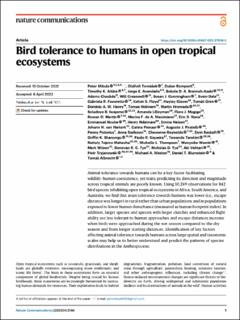| dc.contributor.author | Mikula, Peter | |
| dc.contributor.author | Tomášek, Oldřich | |
| dc.contributor.author | Romportl, Dušan | |
| dc.contributor.author | Aikins, Timothy K. | |
| dc.contributor.author | Avendaño, Jorge E. | |
| dc.contributor.author | Braimoh-Azaki, Bukola D A | |
| dc.contributor.author | Chaskda, Adams | |
| dc.contributor.author | Cresswell, Will | |
| dc.contributor.author | Cunningham, Susan J. | |
| dc.contributor.author | Dale, Svein | |
| dc.contributor.author | Favoretto, Gabriela R. | |
| dc.contributor.author | Floyd, Kelvin S. | |
| dc.contributor.author | Glover, Hayley | |
| dc.contributor.author | Grim, Tomáš | |
| dc.contributor.author | Henry, Dominic A. W. | |
| dc.contributor.author | Holmern, Tomas | |
| dc.contributor.author | Hromada, Martin | |
| dc.contributor.author | Iwajomo, Soladoye B. | |
| dc.contributor.author | Lilleyman, Amanda | |
| dc.contributor.author | Magige, Flora J. | |
| dc.contributor.author | Martin, Rowan O. | |
| dc.contributor.author | de A. Maximiano, Marina F. | |
| dc.contributor.author | Nana, Eric D. | |
| dc.contributor.author | Ncube, Emmanuel | |
| dc.contributor.author | Ndaimani, Henry | |
| dc.contributor.author | Nelson, Emma | |
| dc.contributor.author | van Niekerk, Johann H. | |
| dc.contributor.author | Pienaar, Carina | |
| dc.contributor.author | Piratelli, Augusto J. | |
| dc.contributor.author | Pistorius, Penny | |
| dc.contributor.author | Radkovic, Anna | |
| dc.contributor.author | Reynolds, Chevonne | |
| dc.contributor.author | Røskaft, Eivin | |
| dc.contributor.author | Shanungu, Griffin K. | |
| dc.contributor.author | Siqueira, Paulo R. | |
| dc.contributor.author | Tarakini, Tawanda | |
| dc.contributor.author | Tejeiro-Mahecha, Nattaly | |
| dc.contributor.author | Thompson, Michelle L. | |
| dc.contributor.author | Wamiti, Wanyoike | |
| dc.contributor.author | Wilson, Mark | |
| dc.contributor.author | Tye, Donovan R. C. | |
| dc.contributor.author | Tye, Nicholas D. | |
| dc.contributor.author | Vehtari, Aki | |
| dc.contributor.author | Tryjanowski, Piotr | |
| dc.contributor.author | Weston, Michael A. | |
| dc.contributor.author | Blumstein, Daniel T. | |
| dc.contributor.author | Albrecht, Tomáš | |
| dc.date.accessioned | 2024-01-12T08:04:54Z | |
| dc.date.available | 2024-01-12T08:04:54Z | |
| dc.date.created | 2023-05-10T10:16:10Z | |
| dc.date.issued | 2023 | |
| dc.identifier.citation | Nature Communications. 2023, 14 . | en_US |
| dc.identifier.issn | 2041-1723 | |
| dc.identifier.uri | https://hdl.handle.net/11250/3111230 | |
| dc.description.abstract | Animal tolerance towards humans can be a key factor facilitating wildlife–human coexistence, yet traits predicting its direction and magnitude across tropical animals are poorly known. Using 10,249 observations for 842 bird species inhabiting open tropical ecosystems in Africa, South America, and Australia, we find that avian tolerance towards humans was lower (i.e., escape distance was longer) in rural rather than urban populations and in populations exposed to lower human disturbance (measured as human footprint index). In addition, larger species and species with larger clutches and enhanced flight ability are less tolerant to human approaches and escape distances increase when birds were approached during the wet season compared to the dry season and from longer starting distances. Identification of key factors affecting animal tolerance towards humans across large spatial and taxonomic scales may help us to better understand and predict the patterns of species distributions in the Anthropocene. | en_US |
| dc.language.iso | eng | en_US |
| dc.publisher | Nature | en_US |
| dc.rights | Navngivelse 4.0 Internasjonal | * |
| dc.rights.uri | http://creativecommons.org/licenses/by/4.0/deed.no | * |
| dc.title | Bird tolerance to humans in open tropical ecosystems | en_US |
| dc.title.alternative | Bird tolerance to humans in open tropical ecosystems | en_US |
| dc.type | Peer reviewed | en_US |
| dc.type | Journal article | en_US |
| dc.description.version | publishedVersion | en_US |
| dc.source.pagenumber | 10 | en_US |
| dc.source.volume | 14 | en_US |
| dc.source.journal | Nature Communications | en_US |
| dc.identifier.doi | 10.1038/s41467-023-37936-5 | |
| dc.identifier.cristin | 2146686 | |
| cristin.ispublished | true | |
| cristin.fulltext | original | |
| cristin.qualitycode | 2 | |

